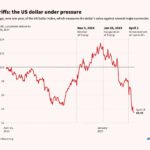This year’s weakness, however, has been driven by higher US tariffs on Indian exports and an exodus of foreign investors from the local stock market.
In a bid to stabilise the rupee, the Reserve Bank of India has sold more than $30 billion of foreign-currency assets since the end of July, according to Bloomberg Economics estimates, and in doing so managed to avert a new low in mid-October.
But on Nov. 21, the rupee slumped to 89.4812 against the US dollar, which suggests the central bank stopped defending the currency. Analysts suspect the RBI wants to conserve its reserves in the event of delayed trade talks with the US.
The currency is now at a crucial juncture. Possible improvements in US-India trade ties and a lower tariff rate could ease pressure on the currency. But if that doesn’t eventuate, the RBI may be forced to support the rupee further.
What caused such a weak rupee this year?
The rupee first dipped in January before it eked out slight gains against the dollar in March and April. At its strongest, in early May, the currency traded at 83.7538 per dollar. This was around the same time investors were betting India would be among the first to clinch a trade deal with the US. Expectations of lower tariffs on Indian exports fuelled optimism that foreign capital would flow into the country as companies sought manufacturing hubs outside of China.
The tide turned in July, when President Donald Trump announced plans to impose higher-than-anticipated tariffs and threatened to penalise India for purchasing Russian energy and weapons. The levies dashed New Delhi’s hopes of preferential treatment over its Asian peers, and the rupee suffered its worst monthly loss since 2022. In August, the US set tariffs on most Indian exports at 50% — the highest across Asia — which included a “secondary” 25% penalty tariff for India’s trade with Russia. The rupee fell to a series of record lows, breaching 88 per dollar.
In September, the currency weakened further after reports that President Trump had urged European nations to impose similar Russia-related penalty tariffs on Indian imports and that the US planned to raise the fee for its high-skilled H-1B visa — the vast majority of which go to Indian-born workers — from a few hundred dollars to $100,000.
A frantic foreign exodus from Indian equities — driven by US tariffs, high stock valuations and concerns about economic growth and tepid corporate earnings — has piled additional pressure on the rupee. As of Nov. 25, foreign investors had pulled out nearly $16.3 billion from Indian shares this year, closing in on a record outflow set in 2022.
Traders have speculated that the RBI has been intervening on and off this year to stabilise the currency, most notably in February and again in October. But on Nov. 21, the rupee abruptly fell to an all-time low, suggesting that on that occasion the central bank chose not to step in.
What is the central bank’s intervention strategy?
The RBI intervenes only when it needs to contain excessive volatility, rather than targeting any specific value relative to the dollar, the central bank’s governor has said repeatedly. It typically does so by selling US dollars from its foreign-exchange reserves—which helps curb the dollar’s rise and supports the rupee — or through offshore derivatives contracts in which it commits to sell dollars at a predetermined price at a future date. Those reserves now stand at about $693 billion — among the largest in the world and enough to cover about 11 months of imports.
Why has the rupee been faring worse than other currencies?
The rupee’s overall depreciation this year hasn’t come as a huge surprise; the currency has lost value every year since 2018. In fact, the RBI Governor Sanjay Malhotra downplayed the rupee’s weakness in an interview on Nov. 24, saying it was to be expected given the inflation gap between India and advanced economies.
One reason is that those countries face far fewer US tariffs on their exports. India’s economy — though largely driven by its domestic market — has been hit particularly hard because the US is its largest export market.
Another drag on the rupee has been India’s persistent current account deficit, which means it imports more than it exports. India must buy foreign currency — normally US dollars — to pay for those imports, which weakens demand for the rupee. By contrast, Taiwan, Malaysia, Thailand and South Korea are all running current account surpluses, which means they export more than they import, earning foreign currency from their sales abroad.
Read Also: Nifty at record high, but underperforming IT stocks still down up to 50% from peak





















